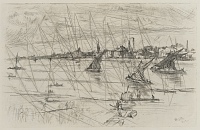Etchings Institutions search term: wunderlich
Battersea Reach | ||
| Number: | 96 | |
| Date: | 1863 | |
| Medium: | etching and drypoint | |
| Size: | 134 x 209 mm | |
| Signed: | 'Whistler.' at lower right | |
| Inscribed: | '1863. - ' at lower right | |
| Set/Publication: | 'Cancelled Plates', 1879 | |
| No. of States: | 1 | |
| Known impressions: | 19 | |
| Catalogues: | K.90; M.90 | |
| Impressions taken from this plate (19) | ||
KEYWORD
TITLE
Possibly 'Battersea Reach' (1877, Whistler). 1
'Opposite Lindsay Row' (1898, Wunderlich's). 2
'Sailing Boats off Battersea' (1905, ISSPG). 3
'Battersea Reach' (1909, Howard Mansfield (1849-1938) ). 4
Although it is not absolutely certain that it is Whistler's title (because the first mention listed above may refer to another etching), the title 'Battersea Reach' was preferred by later cataloguers.
1: Whistler to C. A. Howell, 14-16 November [1877], GUW #13668.
2: New York 1898 (cat. no. 294).
3: London Mem. 1905 (cat. no. 384).
4: Mansfield 1909 (cat. no. 90).
DESCRIPTION
5: ibid.
SITE
6: 'Money-Market & City Intelligence', The Times, London, 4 March 1863, p. 7.
